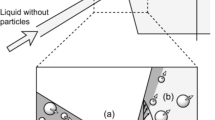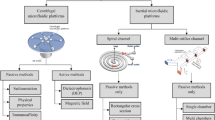Abstract
Separation/purification of nuclei from cells is a critical process required for medical and biochemical research applications. Here, we report a flow-through microfluidic device for isolating cell nuclei by selectively digesting the cell membrane by using the concept of hydrodynamic filtration (HDF). When a cell suspension is continuously introduced into a microchannel (main channel) possessing multiple side channels, cells flow through the main channel, whereas the carrier medium of the cells is drained through the side channels. Introductions of a cell treatment solution containing a surfactant and a washing buffer enable the two-step exchange of the carrier-medium and the cell treatment by the surfactant for a short span of time. The precise control of the treatment time by changing the flow rate and/or the size of the microchannel enables the selective digestion of cell membranes, resulting in the isolation of cell nuclei after separation from membrane debris and cytoplasmic components according to size. We examined several surfactant molecules and demonstrated that Triton X-100 exhibited high efficiency regarding nucleus isolation for both adherent (HeLa) and nonadherent (JM) cells, with a recovery ratio of ∼80 %. In addition, the isolation efficiency was evaluated by western blotting. The presented flow-through microfluidic cell-nucleus separator may be a useful tool for general biological applications, because of its simplicity in operation, high reproducibility, and accuracy.




Similar content being viewed by others
References
A. Adamo, K.F. Jensen, Lab Chip 8(8), 1258–1261 (2008)
T.M. Antalis, D. Godbolt, Nucleic Acids Res. 19(15), 4301 (1991)
S.A. Beausoleil, M. Jedrychowski, D. Schwartz, J.E. Elias, J. Villén, J. Li, M.A. Cohn, L.C. Cantley, S.P. Gygi, Proc. Natl. Acad. Sci. USA 101(33), 12130–12135 (2004)
L. Brichese, N. Barboule, C. Heliez, A. Valette, Exp. Cell Res. 278(1), 101–111 (2002)
S. Choi, S. Song, C. Choi, J.-K. Park, Anal. Chem. 81(5), 1964–1968 (2009)
C.R. Cotter, J.A. Blaho, Methods Mol. Biol. 559(6), 371–387 (2009)
D.A. Dean, H. Kasamatsu, J. Biol. Chem. 269(7), 4910–4916 (1994)
J.D. Dignam, R.M. Lebovitz, R.G. Roeder, Nucleic Acids Res. 11(5), 1475–1489 (1983)
J. El-Ali, P.K. Sorger, K.F. Jensen, Nature 442(7101), 403–411 (2006)
M.B. Fox, D.C. Esveld, A. Valero, R. Luttge, H.C. Mastwijk, P.V. Bartels, A. van den Berg, R.M. Boom, Anal. Bioanal. Chem. 385(3), 474–485 (2006)
S. Haeberle, R. Zengerle, Lab Chip 7(9), 1094–1110 (2007)
R. Hancock, Y. Hadj-Sahraoui, PLoS One 4(10), e7560 (2009)
K. Illmensee, P.C. Hoppe, Cell 23(1), 9–18 (1981)
H. Ishihara, K. Kuribayashi, S. Takeuchi, Proc. IEEE 22nd MEMS 367–370 (2009)
L.-S. Jang, M.-H. Wang, Biomed Microdev. 9(5), 737–743 (2007)
Y.-J. Kim, S. Noguchi, Y.K. Hayashi, T. Tsukahara, T. Shimizu, K. Arahata, Hum. Mol. Genet. 10(11), 1129–1139 (2001)
H.J. Lee, J.-H. Kim, H.K. Lim, E.C. Cho, N. Huh, C. Ko, J.C. Park, J.-W. Choi, S.S. Lee, Lab Chip 10(5), 626–633 (2010)
M. Lesort, K. Attanavanich, J. Zhang, G.V.W. Johnson, J. Biol. Chem. 273(20), 11991–11994 (1998)
Y.-C. Lin-Lee, L.V. Pham, A.T. Tamayo, L. Fu, H.-J. Zhou, L.C. Yoshimura, G.L. Decker, R.J. Ford, J. Biol. Chem. 281(27), 18878–18887 (2006)
R.C. Little, J. Colloid Interf. Sci. 65(3), 587–588 (1978)
H. Lu, S. Gaudet, M.A. Schmidt, K.F. Jensen, Anal. Chem. 76(19), 5705–5712 (2004)
M. Macaluso, M. Montanari, C.M. Marshall, A.J. Gambone, G.M. Tosi, A. Giordano, M. Massaro-Giordano, Cell Death Differ. 13(9), 1515–1522 (2006)
J.S. Marcus, W.F. Anderson, S.R. Quake, Anal. Chem. 78(9), 3084–3089 (2006)
W.M. Rideout III, K. Hochedlinger, M. Kyba, G.Q. Daley, R. Jaenisch, Cell 109(1), 9–18 (2002)
A.C. Rowat, J. Lammerding, J.H. Ipsen, Biophys. J. 91(12), 4649–4664 (2006)
A.M. Skelley, O. Kirak, H. Suh, R. Jaenisch, J. Voldman, Nat. Methods 6(2), 147–152 (2009)
S. Sugaya, M. Yamada, M. Seki, Biomicrofluidics 5(2), 024103 (2011)
J.N. Umbreit, J.L. Strominger, Proc Natl. Acad. Sci. USA 70(10), 2997–3001 (1973)
N. Xia, T.P. Hunt, B.T. Mayers, E. Alsberg, G.M. Whitesides, R.M. Westervelt, D.E. Ingber, Biomed Microdev. 8(4), 299–308 (2006)
K. Xu, R.F. Ludueña, Cell Motil. Cytoskeleton 53(1), 39–52 (2002)
M. Yamada, M. Seki, Lab Chip 5(11), 1233–1239 (2005)
M. Yamada, K. Kano, Y. Tsuda, J. Kobayashi, M. Yamato, M. Seki, T. Okano, Biomed Microdev. 9(5), 637–645 (2007)
M. Yamada, J. Kobayashi, M. Yamato, M. Seki, T. Okano, Lab Chip 8(5), 772–778 (2008)
T.-S. Yeh, R.-H. Hsieh, S.-C. Shen, S.-H. Wang, M.-J. Tseng, C.-M. Shih, J.-J. Lin, Cancer Res. 64(22), 8334–8340 (2004)
Acknowledgments
This study was supported in part by Grants-in-aid for Scientific Research A (20241031) and for Innovative Areas “Bio Assembler” (23106007) from Ministry of Education, Culture, Science, and Technology (MEXT), Japan, and for Improvement of Research Environment for Young Researchers from Japan Science and Technology Agency (JST). We thank Dr. Rie Utoh at Tokyo Women’s Medical University for technical advice.
Author information
Authors and Affiliations
Corresponding author
Rights and permissions
About this article
Cite this article
Toyama, K., Yamada, M. & Seki, M. Isolation of cell nuclei in microchannels by short-term chemical treatment via two-step carrier medium exchange. Biomed Microdevices 14, 751–757 (2012). https://doi.org/10.1007/s10544-012-9653-8
Published:
Issue Date:
DOI: https://doi.org/10.1007/s10544-012-9653-8




